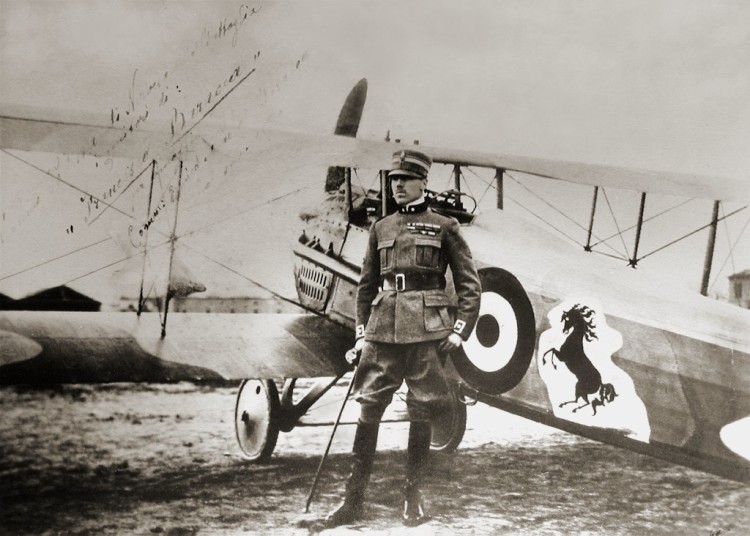The Ferrari emblem is perhaps the most readily recognisable of Italian motor manufacturers. Despite the exclusivity and high cost of Ferrari automobiles, the company’s distinctive logo is regularly reproduced on merchandise and clothing, which are purchased by individuals who aspire to the status of the Ferrari brand. Probably few of them know the meaning behind the logo that they sport on everything from toiletry bags to laptops.
The founding father of Ferrari, Enzo Ferrari, related the following story about the origins of the company’s emblem:
The horse was painted on the fuselage of the fighter plane of Francesco Baracca — a heroic airman of the first world war. In ’23, I met count Enrico Baracca, the hero’s father, and then his mother, countess Paulina, who said to me one day, ‘Ferrari, put my son’s prancing horse on your cars. It will bring you good luck’. The horse was, and still is, black, and I added the canary yellow background which is the colour of Modena.
Francesco Baracca was a the son of a wealthy Italian landowner and was born in 1888 in the north of Italy. As with many well-to-do European gentlemen of the time, Francesco enjoyed country pursuits and was an avid equestrian. His skills in horsemanship were further honed after he enrolled in the Military Academy of Modena in 1907. Shortly afterwards, in 1908, he received an officer’s commission in the Royal Piedmont Cavalry (Piemonte Reale Cavalleria), which was a prestigious regiment of heavy cavalry. Prior to WWI he was stationed in Rome, where he became interested in flying. Military aviation was in its infancy at the time, but already held out the promise of fame and military glory for early aviators, who were christened as ‘knights of the sky’. The metaphor is an apt one, since at the outbreak of WWI air forces were not yet the independent branches of service that they are today, but were components of the army – often cavalry regiments. This was the case with Italian military aviation during WWI, which was organised into the Battaglione Aviatori (Aviation Battalion) of the Royal Italian Army. Many of the Battaglione Aviatori‘s early flyers were drafted from cavalry regiments, including Francesco Baracca. Aviators often chose to decorate their aircraft with personalised markings, in order to express their individuality and personalities. The tradition continues to this day in the form of ‘nose art’, seen on modern military aircraft. Baracca chose a raring stallion as his own personal motif, an allusion to his equestrian skill and cavalry ties.
Baracca would become a fighter ace during the War (i.e. scoring more than five victories) as well as Italy’s most successful fighter pilot. He was credited with 34 aerial victories. He died in combat after his plane was shot down by ground fire on 19 June 1918.
When adopting the prancing stallion as his emblem, Enzo Ferrari modified the design slightly (the stallion’s tail points upward in the Ferrari logo) and changed the background colour to yellow, in tribute to his hometown of Modena. He also added the colours of the Italian flag to the topmost border of the badge and the letters ‘S’ and ‘C’, which stands for Scuderia Ferrari. ‘Scuderia’ translates into ‘stable’, signifying that the motor cars are from the Ferrari stable – a fitting homage to both the equestrian and racing worlds that are represented in the Ferrari heritage.
The first time the stallion featured on a car, it was emblazoned on an Alfa Romeo that Enzo Ferrari was racing in 1932. The first Ferrari debuted in 1947, sporting the current emblem on its nose. An interesting note on the usage of the badge is that when it appears on the nose of a Ferrari, it is always the rectangular version (pictured above). However, when used on the sides of the car, the badge appears as a shield (apparently this is an optional extra).

A classic Ferrari Testarossa from 1987. This picture shows the rectangular badge on the nose and the shield badge on behind the wheel arch.
One is inclined to think that Baracca would have enjoyed the notion that his trademark stallion would endure for more than a century, albeit somewhat anonymously, on the most prestigious and flamboyant motor cars in the world.


